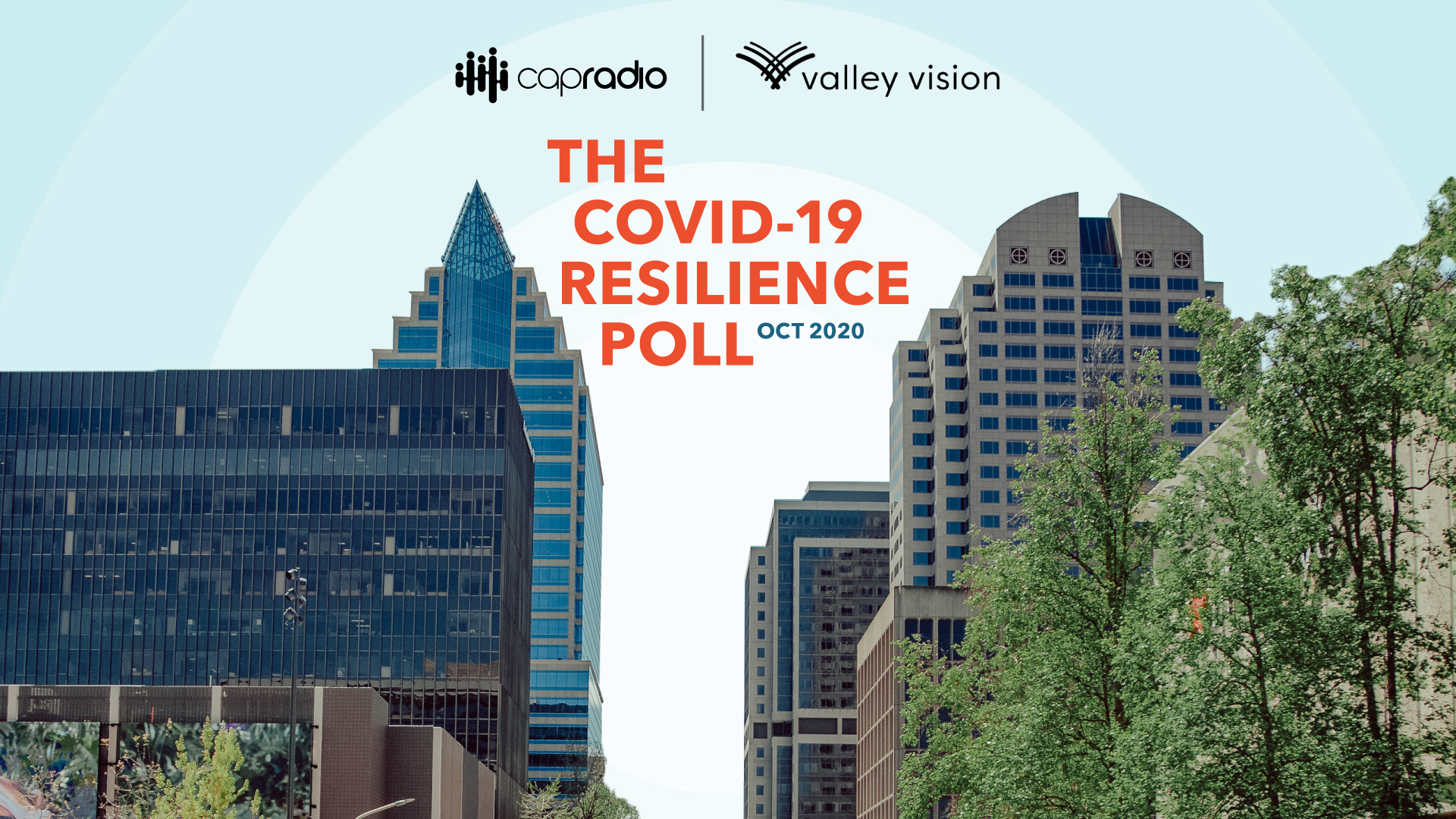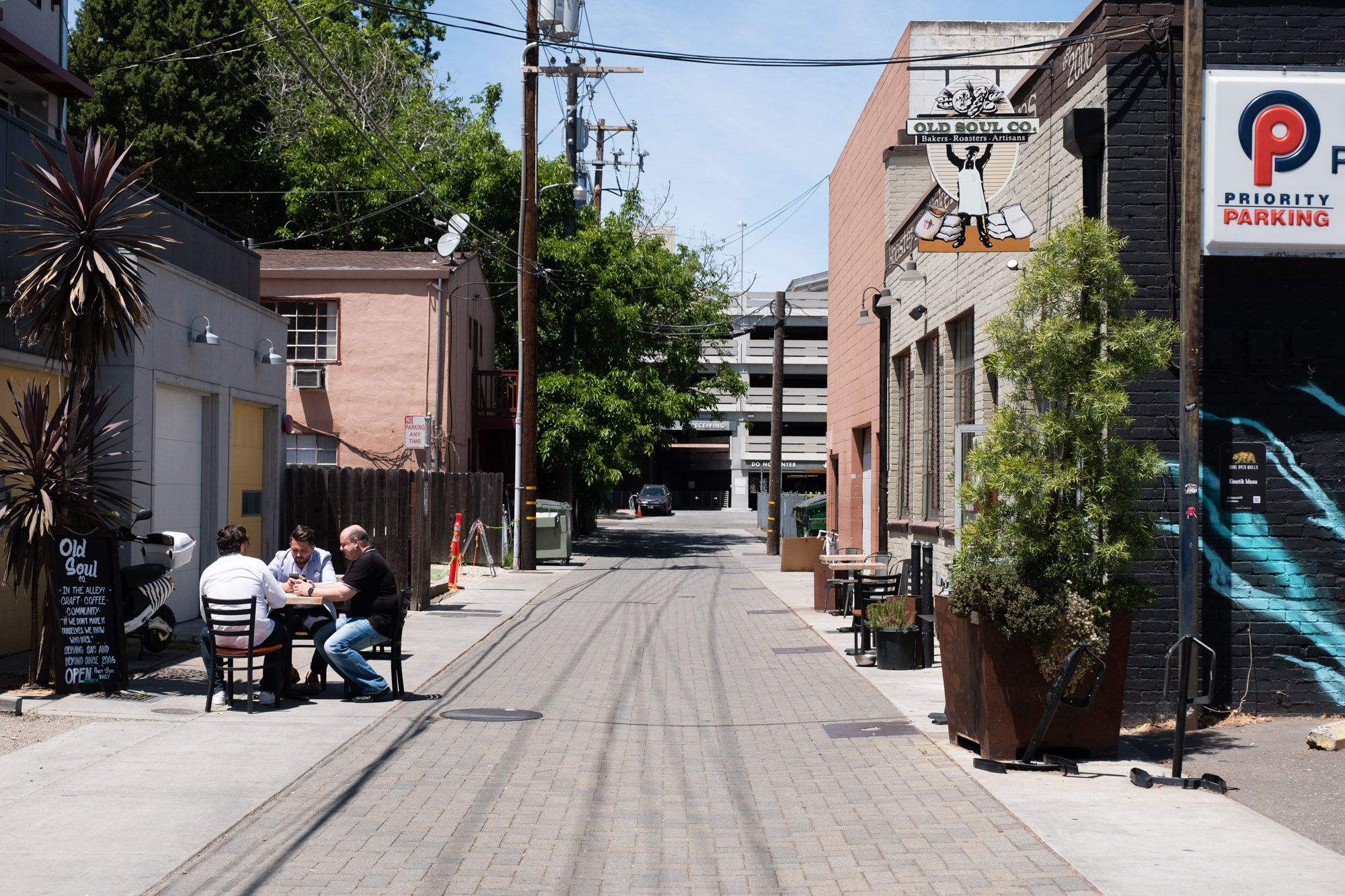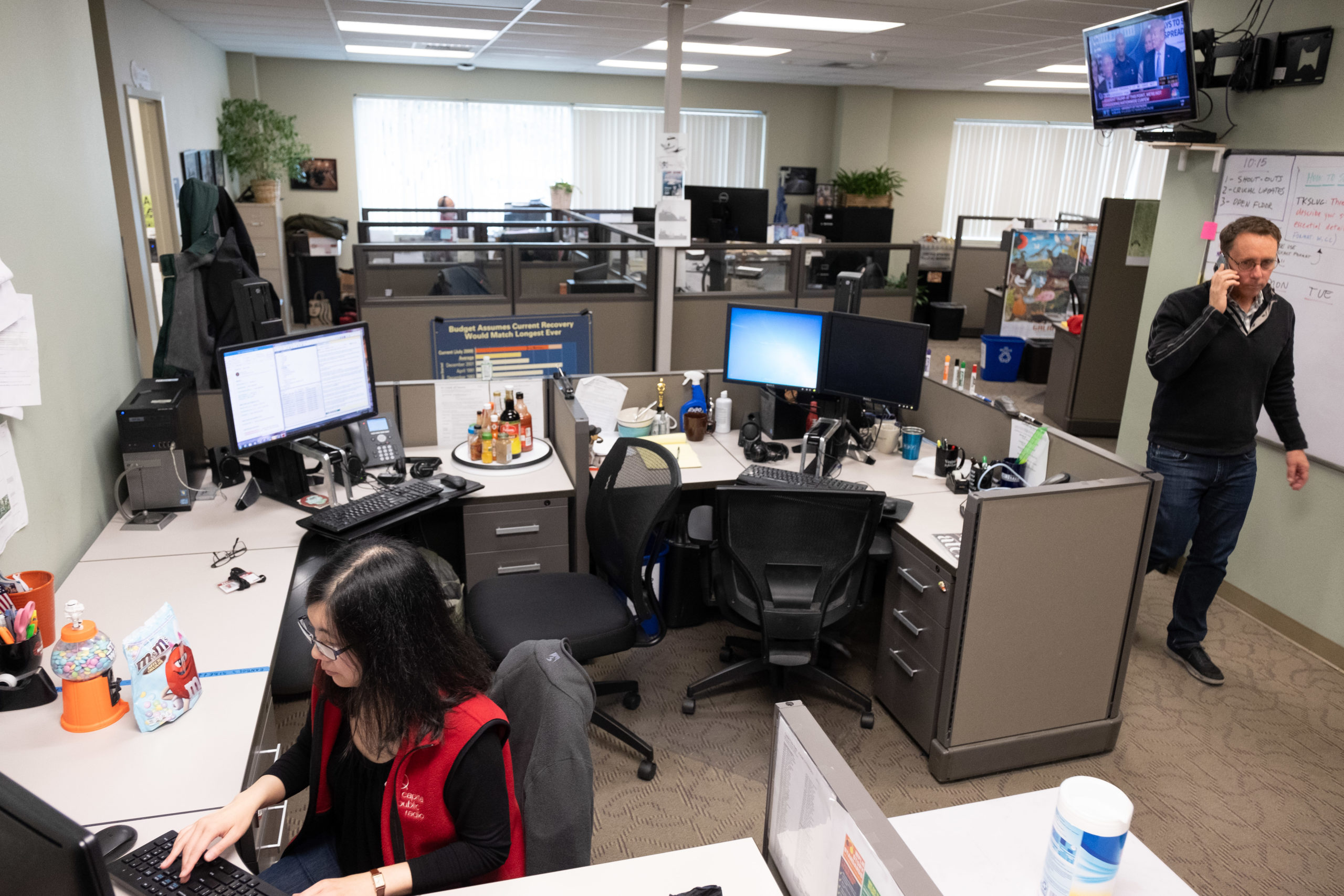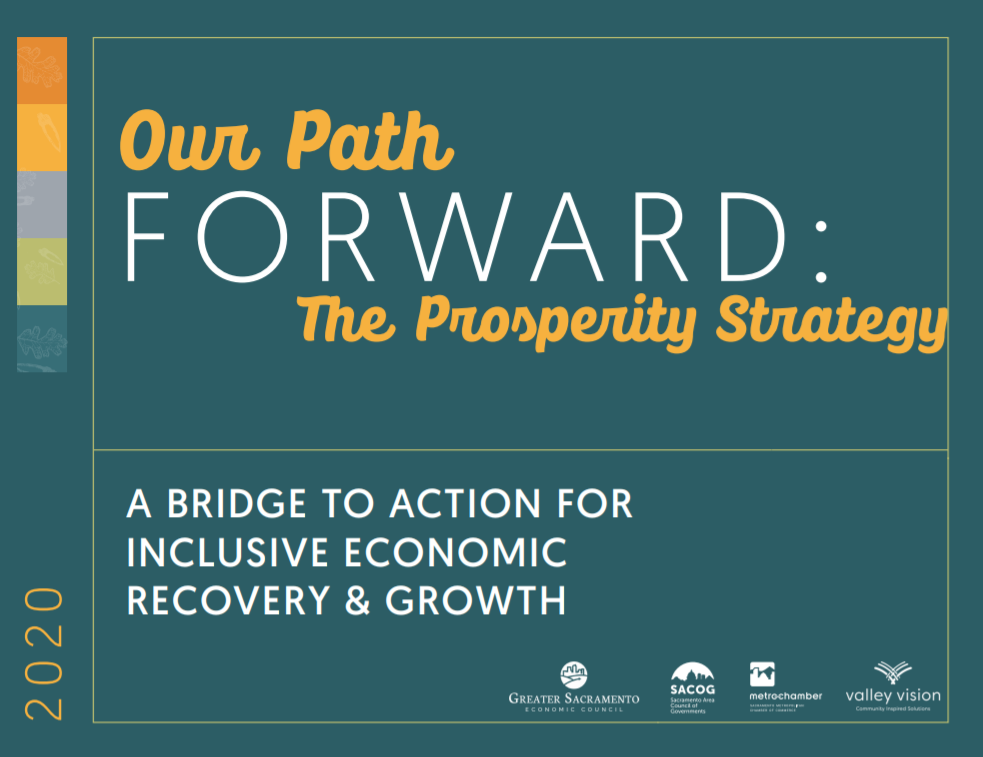The COVID-19 Resilience Poll #2 (October 2020)

The COVID-19 Resilience Poll series tracks the experiences, perceptions, concerns, and hopes of people in the Capital region, via three polls conducted through the first twelve months of the COVID-19 pandemic – including health impacts and fears, the experiences of the varying public orders and guidance, and the economic consequences of the pandemic. This poll, the second in our series, was in the field September 4-18, 2020, and is demographically representative of the Capital region, encompassing eight counties, including Sacramento, Yolo, El Dorado, Placer, Yuba, Sutter, Solano and San Joaquin counties, and has a margin of error of plus or minus three percent.
This poll paints a picture of the many ways that COVID-19 is impacting our region. This is the second in a series of polls fielded by Valley Vision and CapRadio, in partnership with the Institute for Social Research at Sac State. These surveys are helping us understand and navigate the challenges ahead as we aim to not just understand the impacts and recover from the setbacks of COVID-19, but also reimagine a more equitable, sustainable, and just future. You can also access CapRadio’s coverage of the poll at www.capradio.org.

Levels of concern continue to reflect disparities in our communities. Respondents who are Black, Hispanic, in a lower income bracket, or younger, reported higher levels of concern across most measures.

As many as 63% of respondents reported feeling depressed at least once in the last seven days, and 82% of respondents reported feeling anxious at least once in the last seven days.

17% of respondents reported that they are currently unemployed, while only 8% reported being unemployed in January.

Men and women are experiencing the impacts of having their children doing schooling remotely very differently — nearly 40% of women respondents describe it as “very” challenging, as compared to only 13% of men.

48-57% of those with children think that schools at all levels should open in-person; only 26-28% of those without children share the same view.

Republicans are more likely than Democrats to support a return to in-person schooling either as usual or with minor adjustments to accommodate COVID-19.
Photo credit: Andrew Nixon/CapRadio
Webinar: The COVID-19 Resilience Poll

Join Valley Vision and CapRadio for a free webinar exploring the major findings of The COVID-19 Resilience Poll and the link to lived experiences across our region.
The COVID-19 Resilience Poll (2020)

The COVID-19 Resilience Poll tracks the experiences, perceptions, concerns, and hopes of people in the Capital region through the early stages of the COVID-19 pandemic including the health impacts and fears, the experiences through the shelter in place order, and the economic fallout from the pandemic. This public opinion poll was in the field May 12-27, 2020, and is demographically representative of the Capital region, encompassing eight counties, including Sacramento, Yolo, El Dorado, Placer, Yuba, Sutter, Solano and San Joaquin counties. The margin of error is plus or minus three percent.
This poll paints a picture of the many ways that COVID-19 is impacting our region. This is also the first in a series of polls that Valley Vision and CapRadio will field, in partnership with the Institute for Social Research at Sac State. These surveys will help us understand and navigate the challenges ahead as we aim to not just understand the impacts and recover from the setbacks of COVID-19, but also reimagine a more equitable, sustainable, and just future. You can also access CapRadio’s coverage of the poll at capradio.org/resilience.

We found that COVID-19 has severely impacted the people in our communities – including their mental, physical, and emotional health; their daily life and routines, and their economic security.

There are deep disparities of the intensity of concern and impact across different populations, with Black and Hispanic respondents feeling the impacts more severely.

Nearly half of respondents have lost income and about a third are struggling to afford basic needs including rent or mortgage, bills, and paying down debt.

Many respondents are working remotely as a result of COVID-19 – however those in higher incomes were more likely to go remote and were more likely to have already been working remotely.

There is also a significant political dimension in the region and many respondents are critical of leadership – whether it is because they think that leadership has failed to deliver an effective response or because they think the response is overblown and creating more harm.

Respondents’ most significant worries included continued illness, spread of disease and the impact on the economy.
Photo credit: Andrew Nixon/CapRadio
The Prosperity Strategy: Our Path Forward (2020)

Our Path Forward: The Prosperity Strategy is a strategic framework and bridge to action for the six-county Sacramento Region that prioritizes our core economic initiatives and will result in a more prosperous, equitable and resilient region.
The plan is being advanced by Valley Vision, the Greater Sacramento Economic Council, Sacramento Metropolitan Chamber of Commerce, Sacramento Area Council of Governments, and the Sacramento Asian Pacific Chamber of Commerce. Learn more at https://theprosperitystrategy.org/.
Greater Sacramento Region Prosperity Strategy

A Comprehensive Economic Development Strategy (CEDS) is a region’s economic roadmap that ensures a strong, inclusive, and equitable economy by bringing together public, private, and civic stakeholders to establish regional goals, objectives, and a plan of action. The CEDS process analyzes existing regional conditions, opportunities, and global economic conditions, leading to a region-specific strategy-driven plan for economic prosperity. This 2020 update to the CEDS was accomplished as part of the region’s overall inclusive economic development strategy, “Our Path Forward: The Prosperity Strategy,” a joint effort of the Greater Sacramento Economic Council, Sacramento Metro Chamber of Commerce, Sacramento Area Council of Governments (SACOG), and Valley Vision.
The Capital Region’s previous CEDS, Next Economy, covered 2013 to 2018. To prepare for the region’s next CEDS, Valley Vision, Greater Sacramento Economic Council, Sacramento Metro Chamber, and Sacramento Area Council of Governments launched the Prosperity Strategy process in 2018. The strategy builds upon the Brookings Institution market assessment findings and framework of five market levers: Tradable Clusters, Innovation, Talent, Infrastructure, and Governance. The Greater Sacramento Region Prosperity Strategy (CEDS) focused on three principle goals: improve business, support people, and develop place. The Prosperity Strategy is a triple bottom line approach that will ensure a strong, inclusive, and equitable economy for the six-county Sacramento region. It serves as the region’s CEDS.
The goal is to grow the Sacramento Region’s economy in ways that support all of the region’s residents and communities by prioritizing core economic initiatives resulting in a more aligned, prosperous and resilient Sacramento Region.
An effective CEDS allows a region to maximize its potential by serving as a roadmap for future economic development endeavors. A CEDS qualifies a region for U.S. Economic Development Administration (EDA) funding assistance, under its Public Works and Economic Adjustment Assistance programs. The CEDS must be fully updated every five years in order to stay relevant with changing economic conditions, with annual progress reports.
Access both the Prosperity Strategy and the full CEDS here:
Valley Vision serves as the project manager for the CEDS process. The six-county 2020 CEDS was posted for public comment for 30 days, closing on March 13, 2020. Comments submitted for the CEDS were reviewed by Valley Vision and response were provided. The CEDS was approved by EDA, as detailed in this blog post by Valley Vision’s Trish Kelly.
The CEDS is conducted in collaboration with the Prosperity Partnership: Greater Sacramento Area Economic Council, Sacramento Area Council of Governments, Sacramento Metropolitan Chamber of Commerce, and Valley Vision. The findings, conclusions, and recommendations are based on multiple sources and work product that include but are not limited to the Prosperity Partnership, RW Ventures, Brookings Institution, Centers of Excellence, and regional partners.
For further questions, please email Trish Kelly.
Regional Attitudes on Workforce and Education: The Future of Work (2020)
The acceleration of technology innovation is one of the most significant transformative forces of our time. Today’s innovations, such as digitalization, automation, artificial intelligence (AI) and other technologies, have changed the nature of our national and global economy and are changing the nature of work across all sectors of industry, impacting workers as skill and competency needs shift.
Valley Vision and the Institute for Social Research (ISR) at Sacramento State conducts public opinion polls, drawing from a regional panel that demographically represents the six county region (El Dorado, Placer, Sacramento, Sutter, Yolo, and Yuba counties) and reports at a margin of error of +/-3%. This survey seeks to better understand technology disruption, the gig economy, experiences at work, values towards work, and aspirations for the future.
We found that poll respondents are excited about the future, including changes to their own work life as a result of technology innovation, but still want and need security and protections in place to ensure their success.
Some key findings and conclusions for the future of work in the Capital Region include:

Photo credit: https://www.mim-essay.com/best-mba-schools-in-usa
Respondents are optimistic about new technologies and 82% are excited or confident about the effect that technology innovation will have on their future job prospects. Despite this excitement, a major skill shift is underway and some workers are at risk of losing jobs.

The “gig” economy has a significant impact on our region’s people and economy. About one-third of respondents currently earn income through employment “gigs” and one-quarter report that income from the gig economy is their primary source of income.

Despite changes to the nature of work respondents still value job security and long-term service to an organization. Although younger generations tend to have shorter job tenure, workers of any age are looking for the same things – meaningful work, opportunities to grow, recognition for contributions, and high performing companies.

Entrepreneurship is a key aspect of the modern economy. 62% of respondents believe that they have entrepreneurial skills and abilities and 50% say that they’d take a chance and start their own business. Entrepreneurial networks across the region are key to inclusive economic growth.

Two-thirds of respondents have faced discrimination in the workforce, especially related to sex and race. Ensuring that there are opportunities for social mobility and well-being for all is critical for a thriving and inclusive region.

More than half of respondents are open to leaving the region for better opportunities elsewhere, if needed. Creating, retaining, and attracting talent is a shared responsibility across business, education, community, and individuals.
Valley Vision will present the findings of the workforce and education survey in a series of reports, focusing on how respondents are navigating work and their outlook for their future. Subsequent reports will focus on The Skills of the Future in the Capital region and The Future of Education in the Capital region.
Infographic: 2019 Year in Review
At Valley Vision, we bring communities together to tackle the biggest challenges affecting the livability of our region. By creating common ground built on facts, we inspire leaders to think big and collaborate on bold, long-term solutions that improve people’s lives.
This infographic can be read in under 90 seconds, and highlights some of Valley Vision’s key accomplishments and wins in 2019 as we advance prosperity, equity, and environmental stewardship across the Sacramento region and beyond.
Regional Attitudes: Public Opinion Surveys

Valley Vision and the Institute for Social Research (ISR) at Sacramento State have partnered to provide a series of public opinion reports to generate greater understanding around the most pressing issues facing our region.
Our Regional Attitudes: Public-Opinion Polling Series is focused on lifting high-need population voices and driving data-driven policy changes. The methodology used is highly effective and unique – establishing a scientifically valid and demographically representative panel of regional residents that reflects a microcosm of the region as a whole. Surveys are fielded on a variety of topics and the information is used to craft policy recommendations that help ensure regional priorities reflect public values, interests, and needs.
Through our partnership with the Institute for Social Research at Sacramento State, Valley Vision is the first in the state – perhaps even the country – to apply this scientific approach to a metropolitan area.
Valley Vision’s public opinion research is powered by Western Health Advantage, Sacramento Region Community Foundation, and the Sierra Health Foundation.
Opportunity Zones

Opportunity Zones, created as part of the federal Tax Reform Act of 2017, are a new nationwide tool intended to motivate more capital to be invested in under-served communities across the nation.
Opportunity Zones are defined at the census tract level, and are designated by each State’s Governor. Qualified Opportunity Funds (QOF) provide the mechanism for investment in Opportunity Zones, and any QOF must invest at least 90% of its assets in property or businesses in Opportunity Zones. Investors benefit both from the returns on their investments in QOF and also by being able to shelter capital gains from taxes, by investing them in a QOF. Regulation and policy surrounding Opportunity Zones is very much still in development, at both the federal and state levels, and at the same time interest is rising within the region – from fund managers (private, nonprofit, and public sector), from projects with investment potential, and from potential investors, both individual and institutional.
In response to the fast-paced development of Opportunity Zones, Valley Vision convened a regional Opportunity Zones working group to share up-to-date information about Opportunity Zone developments, and to enhance the likelihood of securing Opportunity Zone investment in the Sacramento Region that benefit the community as a whole. Valley Vision continues to share local, state, and federal information on Opportunity Zones through a monthly newsletter. Click here to subscribe to our newsletter today!
The Opportunity Zone Explorer, created by the Enterprise Community Partners’ Opportunity360 team, is a great tool. Similarly, the LOCUS Opportunity Zone Navigator, by Smart Growth America, is an interactive mapping tool that allows users to search designated census tracts for transit, environmental, economic, housing, and affordability information.
If your organization would like to participate, please contact Valley Vision’s Meg Arnold at meg.arnold@valleyvision.org.
California Stewardship Network

In 2008, the Morgan Family Foundation launched the California Stewardship Network (CSN) as a civic venture, investing in California’s predominant economic regions. CSN began as a civic concept, morphed into an expansive project, and has emerged as an effective network and learning exchange comprised of civic leadership organizations that work together to improve economic, social and environmental conditions across the Golden State.
Today, fifteen regions across California – including the Sacramento Capital Region – make up the California Stewardship Network. Each is developing innovative regional solutions to the state’s most pressing economic, environmental, and community challenges. While each regional team drives its own stewardship strategy, all share a common approach to achieving Triple Bottom Line outcomes: the concept that sustainability through economy, environment and social equity must factor in decision-making. CSN partners with California Forward to organize the annual California Economic Summit.
The California Stewardship Network consists of 15 civic leadership organizations including the Bay Area Council Economic Institute, Chico Stewardship Network, Fresno Business Council, Inland Empire Economic Partnership, Los Angeles County Economic Development Corp, Monterey Bay Economic Partnership, Redwood Coast Rural Action, San Diego Regional Economic Development Corp, San Luis Obispo Economic Vitality Corporation, Sierra Business Council, Silicon Valley Leadership Group, Sonoma County Economic Development Board, Tahoe Prosperity Center, Valley Vision, and Ventura County Economic Development Collaborative.
Regional Attitudes In Focus: Gen Z and Millennials (2019)
Valley Vision and Sacramento State’s Institute for Social Research (ISR) have partnered to conduct four public opinion polls since 2017. Our polls have looked at Capital Region residents’ priorities, values, experiences, and preferences on Civic Amenities, Transportation, Quality of Life, and the Environment.
These polls give insight into Capital Region residents’ views on current issues and help inform decision-makers’ strategies and investments related to public infrastructure and community well-being. This report is part of a series of unique profiles that will zero in on subsets of our region’s population to see how our respective ages or other social, geographic, or demographic characteristics influence our experiences, providing a more in-depth view of our region.
Our first report looks at how Millennials and Gen Z (aged 18-38) collectively view the Sacramento region. How do these generations think about their communities and what are their preferences and priorities for the types of communities that they want to live in?
Regional Attitudes: The Environmental Poll (2019)
Valley Vision and Sacramento State’s Institute for Social Research (ISR) released The Environmental Poll in May 2019, the fourth study in a series that captures residents’ attitudes on important regional issues.
Valley Vision is excited to announce the results of a new scientific public opinion survey about environmental and climate priorities in the Sacramento region. Read on to uncover opinions about green jobs, climate action, preservation of open space, and other new data to help public policy leaders make informed decisions.
Click here to view an interactive website featuring data from The Environmental Poll.